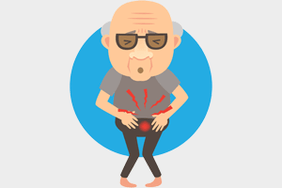Prostatitis is one of the most common urological diseases, accompanied by inflammation of prostate tissue.According to official medical statistics data, prostatitis is diagnosed in each tenth patient.This is due to the complexity of the early diagnosis of the pathology and the frequent course of the disease in a hidden form.As for the age category of men who are at risk, prostatitis was previously considered elderly disease.In recent years, the disease is quickly young.This is due to a sedentary lifestyle, malnutrition, tensions present in the life of a modern person.According to doctors, the treatment of the disease should begin as soon as possible.To do this, you should know how the pathology comes, that first signs of prostatitis in men need to pay close attention.

Types of prostate inflammation and signs classification
The signs of the inflammatory process in the prostate are very diverse, which is associated with the presence of various types in the disease:
- Spicy.It is usually purulent.Signs of inflammation in men, general and specific, are expressed as much as possible, and the pathogen is the pathogenic flora (pathogenic).Therefore, treatment in most cases is the prescription of antibiotics.
- Chronic.It may be the result of an acute process if a man's treatment was performed incorrectly or prematurely.The brilliant symptoms that accompany the purulent process disappear, signs of the disease are much weaker.In remission, the characteristic resources of the process may disappear completely.With the exacerbation of chronic prostatitis, the symptoms are improved, but more often with less intensity than in the acute course of the disease.
Chronic prostatitis in men can initially form without previous signals of acute inflammation.In this case, prostatitis is more often stagnant, that is, due to a sedentary lifestyle, the presence of chronic diseases that affect blood circulation in the pelvic organs.Knowing and being able to distinguish between the first signs of inflammation of the prostate in men is very important because it affects the choice of additional treatment.If in the case of bacterial prostatitis, that the symptoms of general poisoning will indicate, treatment should include antibiotic therapy (tablets, injections, candles), then with a stagnation process, the treatment of congestion will come to first place, ie, image modification and concomitant ailamento therapy.Among the signs of prostatitis, common and specific, can be distinguished.The latter, in turn, is divided into several groups:
- Pain syndrome.
- Urination disorders.Otherwise, this group of signs is called "dysurical disorders."
- Disturbances in the genital area.
- Nervous system changes.
- External manifestations.
- Infertility.
General signs of the disease
General symptoms of prostatitis usually mean generally spaced reactions, indicating the development of an acute inflammatory process in the body.Naturally, in chronic prostatitis, these phenomena are absent (except in cases of pronounced exacerbation).The signs of the active inflammatory process are:
- Increased body temperature.The degree of increase is associated with the severity of inflammation.In acute bacterial prostatitis, especially accompanied by the formation of an abscess, the temperature can reach 39-40 ° C. This condition is accompanied by other pronounced signs of the disease.The first sign of viral inflammation of the prostate gland can also be a high temperature.
- General weakness, headache.
- Chills.The chills are characteristic of bacterial prostatitis.
- Lomota in the muscles.
General manifestations of inflammation are rarely the only marker of prostatitis.But there are exceptions.For example, a chronic slow form of the disease with low severity of specific characteristics sometimes leads to subebrilet (increasing body temperature to 37.2-37.3 ° C).The diagnosis of the disease in a similar situation can only be established after examination and additional studies, including sowing prostate secret to pathogenic microorganisms.

Specific signs of the disease
Consider the specific signs of inflammation of the prostate gland, allowing a precise diagnosis and prescribe the effective treatment of the pathology.
Pain syndrome
Leadership and often the first sign of inflammation of the prostate is pain.The nature of pain may vary significantly.There are sewing pains, painful and cutting the characteristic location.If this is an acute process, they can significantly affect men's lives, lead to sleep and performance.In chronic prostatitis during remission, pain is weak and sometimes completely absent.A typical location of prostatitis pain is a small pelvis.A man may feel pain in the groin below the abdomen, lumbar.Often they emit on the penis, scrotum, testicles.Pain can be accompanied by urination and defecation as well as intensify during erection and ejaculation.A first characteristic sign of the calculating form of the disease may be pain, whose intensity and time of occurrence depends on movement.They appear or intensify, if a man is quickly, jumps, leans.A similar signal is due to mechanical irritation of the pipeline walls.
Urination disorders
They are no less signs of prostate inflammation are several disturbance of urination.Dysuria manifests itself by the need for frequent urination, a feeling of incomplete emptying of the bladder and false urination.The very nature of urination can also change: a man complains about a slow or intermittent urine flow, the need to make efforts to help normally.A formidable, although not the first, sign of inflammation of the prostate is an acute urinary retention.The symptom develops with acute inflammation, accompanied by severe edema of the prostate gland.In case of chronic prostatitis exacerbation, urinary retention, but less intensity may also occur.More often, a man simply cannot maintain a large amount of urine, and a frequent visit is needed to the bathroom.Dysuria and pain syndrome are the first most common manifestations of any form of prostatitis.They are usually initial and prevail in the clinic in acute prostatitis or chronic exacerbation.
Disturbances in the genital sphere
Unpleasant for most stronger sex representatives, though rarely, the manifestation of prostatitis is sexual dysfunction.The intimate sphere disorders are often the result of a chronic inflammatory process and are of a different nature.First of all, there are problems with an erection.It can become slow or a man cannot completely complete sexual intercourse.Ejaculation is disturbed: premature is more common.Over time, the usual severity of the sensations is erased.The problem of physiological purely becomes psychological.The disorders of sexual desire (libido disorders) are developing, problems arise with orgasm.
Nervous system changes

These signs negatively affect the general condition of the nervous system, causing a decrease in mood, depression and sleep disorders.A man ceases to feel his own fullness.Being constant in a state of stress and depression with your own condition can cause aggressive behavior, irritability and tendency to conflict in several men.In such a clinical situation, the treatment of prostatitis only does not lead to the normalization of a psychological state.In this case, an experienced psychologist is required, who can prescribe an antidepressant course, it is possible even after the treatment of the underlying disease.
External manifestations
Along with the disorders of the sexual sphere with prostatitis, a change in sperm is found.For example, purulent prostatitis will be accompanied by a change of color, smell of seed fluid.Depending on the pathogen that caused the process, biological fluid can become yellow, green, yellow-green.Sometimes the discharge of the urethra hole and the external relationship appears.They are also distinguished by color, smell and other characteristics, although a mucous and transparent discharge that appears in the morning is more common.A man can detect pathological impurities in the urine after urination.These are mucous strands, also more often in the morning of the urine.Several pathological impurities in various situations remain the first and sole manifestation of the inflammatory process.Impurities in sperm can have a bloody character, which serves as a signal of calculusal inflammation.The condition is called erythrospermia.This phenomenon arises due to the trauma of the walls with stones.Since the first sign of prostatitis is rare, therefore, when blood impurities in sperm appear, all other diseases should always be excluded.
Male infertility
The only sign of a chronic slow inflammatory process can be infertility.Frequently, while examining a man on the impossibility of involving a child in a stronger sex representative, an ancient inflammatory process is found, which led to a violation of the normal sperm formation process.During the examination in men, a decrease in full sperm is found as well as a decrease in the mobility of male germ cells.
Clinical dependence on the internship and type of disease
Dependence on the clinical image of the disease on the type of prostatitis and its internship is well known.Consider in detail.
Acute bacterial prostatitis clinic
Acute bacterial prostatitis develops due to the penetration of pathogenic and conditionally pathogenic bacteria in the prostate gland.This type of prostatitis requires timely treatment, otherwise the consequence of the disease may be blood poisoning.
Signs:
- chills and elevated body temperature;
- pulling and sharp pain in the lower back, groin and perineum;
- frequent urination;
- insufficiency of bladder independent emptying;
- painful urination;
- Urethra discharge.
Manifestations in chronic bacterial prostatitis
The development of chronic bacterial prostatitis is facilitated by constant hypothermia, premature urination and long sexual abstinence.In the absence of timely therapy, chronic bacterial prostatitis can cause cystitis.

Signs:
- pain in the bottom of the abdomen, perineum, scrotum;
- Violation of power;
- violation of urination.
Symptoms of chronic non -bacterial prostatitis
Non -bacterial prostatitis is the most common form of male urological diseases.Most of the time, this disease is a reflection of extragenital diseases.
Signs:
- Palvic pain syndrome, which can last from 3 to 6 months;
- periodic pains in the urethra, bladder, penis;
- The absence of signs of the inflammatory process secret of the prostate, seed liquid and urine.
Symptoms with stagnated prostate
The main reason for the occurrence of congestive prostatitis is the stagnation of the secrecy of the prostate and venous blood in the pelvis.
Signs:
- Lethargy of orgasic sensations;
- weakened erection;
- Small difficulty in urination;
- painful pain in the perineum;
- quick urination in the morning;
- Decreased libido.
Signs of the asymptomatic course of the disease
This form of prostate pathology is not associated with a bacterial infection and has no pronounced symptoms.Aymptomatic inflammation of the prostate can only be detected by a high level of leukocytes and bacteria in the urine, as well as during biopsy.Whatever the form of prostatitis in a man is detected, the process at any stage can lead to the development of formidable complications.They can become the inflammatory processes of any urinary system (kidneys, bladder), which in turn will lead to the emergence of urolithiasis or even the development of chronic renal failure.Therefore, in order for serious complications not to occur, the disease should be treated in a timely manner and, for timely treatment, of course, you need to recognize the first signs of the disease and resort to a time expert.
























